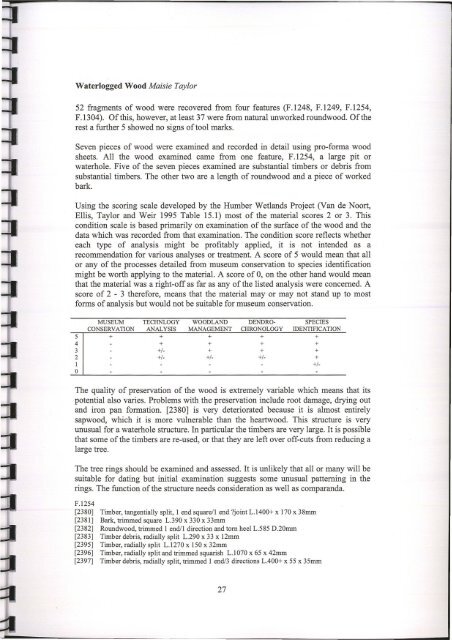Further Excavations At Langtoft. Lincolnshire www - Archaeology ...
Further Excavations At Langtoft. Lincolnshire www - Archaeology ...
Further Excavations At Langtoft. Lincolnshire www - Archaeology ...
Create successful ePaper yourself
Turn your PDF publications into a flip-book with our unique Google optimized e-Paper software.
Waterlogged Wood Maisie Taylor<br />
52 fragments of wood were recovered from four features (F.1248, F.1249, F.1254,<br />
F.1304). Of this, however, at least 37 were from natural unworked roundwood. Of the<br />
rest a further 5 showed no signs of tool marks.<br />
Seven pieces of wood were examined and recorded in detail using pro-forma wood<br />
sheets. All the wood examined came from one feature, F.1254, a large pit or<br />
waterhole. Five of the seven pieces examined are substantial timbers or debris from<br />
substantial timbers. The other two are a length of roundwood and a piece of worked<br />
bark.<br />
Using the scoring scale developed by the Humber Wetlands Project (Van de Noort,<br />
Ellis, Taylor and Weir 1995 Table 15.1) most of the material scores 2 or 3. This<br />
condition scale is based primarily on examination of the surface of the wood and the<br />
data which was recorded from that examination. The condition score reflects whether<br />
each type of analysis might be profitably applied, it is not intended as a<br />
recommendation for various analyses or treatment. A score of 5 would mean that all<br />
or any of the processes detailed from museum conservation to species identification<br />
might be worth applying to the material. A score of 0, on the other hand would mean<br />
that the material was a right-off as far as any of the listed analysis were concerned. A<br />
score of 2 - 3 therefore, means that the material may or may not stand up to most<br />
forms of analysis but would not be suitable for museum conservation.<br />
MUSEUM TECHNLOGY WOODLAND DENDRO- SPECIES<br />
CONSERVATION ANALYSIS MANAGEMENT CHRONOLOGY IDENTIFICATION<br />
5 + + + + +<br />
4 - + + + +<br />
3 - +/- + + +<br />
2 - +/- +/- +/- +<br />
1 - - - - +/-<br />
0 - - - - -<br />
The quality of preservation of the wood is extremely variable which means that its<br />
potential also varies. Problems with the preservation include root damage, drying out<br />
and iron pan formation. [2380] is very deteriorated because it is almost entirely<br />
sapwood, which it is more vulnerable than the heartwood. This structure is very<br />
unusual for a waterhole structure. In particular the timbers are very large. It is possible<br />
that some of the timbers are re-used, or that they are left over off-cuts from reducing a<br />
large tree.<br />
The tree rings should be examined and assessed. It is unlikely that all or many will be<br />
suitable for dating but initial examination suggests some unusual patterning in the<br />
rings. The function of the structure needs consideration as well as comparanda.<br />
F.1254<br />
[2380] Timber, tangentially split, 1 end square/1 end ?joint L.1400+ x 170 x 38mm<br />
[2381] Bark, trimmed square L.390 x 330 x 33mm<br />
[2382] Roundwood, trimmed 1 end/1 direction and torn heel L.585 D.20mm<br />
[2383] Timber debris, radially split L.290 x 33 x 12mm<br />
[2395] Timber, radially split L.1270 x 150 x 32mm<br />
[2396] Timber, radially split and trimmed squarish L.1070 x 65 x 42mm<br />
[2397] Timber debris, radially split, trimmed 1 end/3 directions L.400+ x 55 x 35mm<br />
27

















